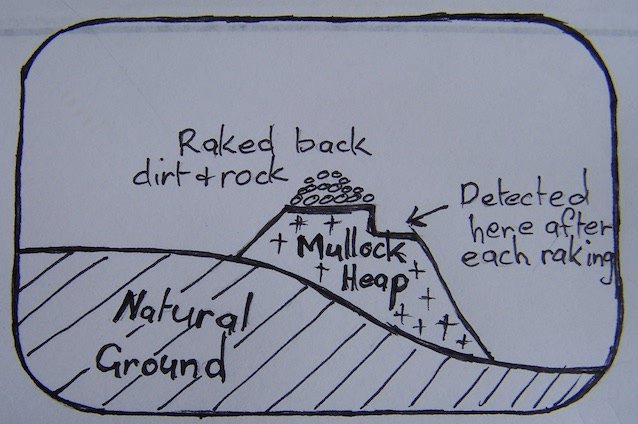Hi Guys,
Just thought I would share with you some observations about my local detecting area in southern NSW. I spend three of four mornings every week looking around the old alluvial workings in search for any sign of yellow left by the old timers. The area has been hit quite hard over the years and from what I have been told, it is becoming more difficult every day to find that bit of gold. I must admit that it does teach you patience and perseverance.
It is quite a difficult area to work. Most of the mullock heaps are either overgrown or covered in a deep layer of dead branches and rubbish.
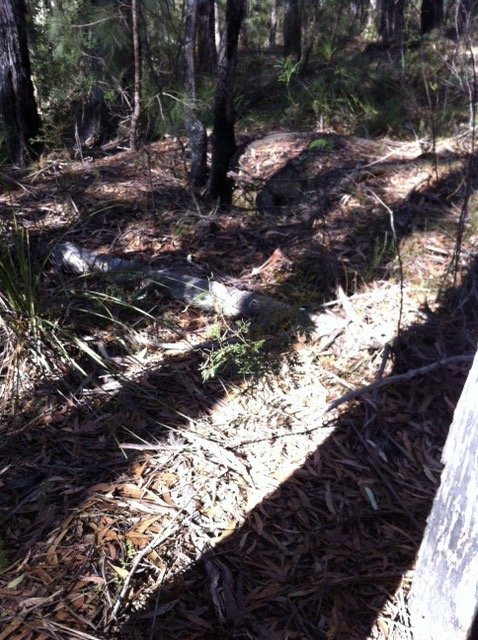
Getting a coil close to the ground is hard work and I am sure that a lot of gold is still hidden under the build up of undergrowth and leaf litter. A bit of raking is often required to reveal the potential of the mound. After raking some interesting information about past activities and mullock heap makeup is evident.
In this area, the gold bearing gravel/ clay is generally a yellow/ orange colour.
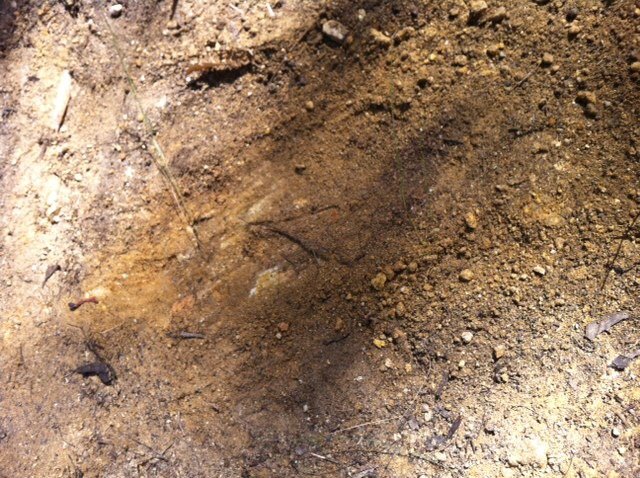
Dark coloured soil or white sandy gravel is normally found close to ground level and has a lower chance of containing nuggets. Red clay and hot rocks appear to form another layer in the soil profile and do nothing but upset the detector. I spend some time on the lighter gravels and dark soil but avoid the red dirt like the plague. I mostly focus on the yellow/ orange material.
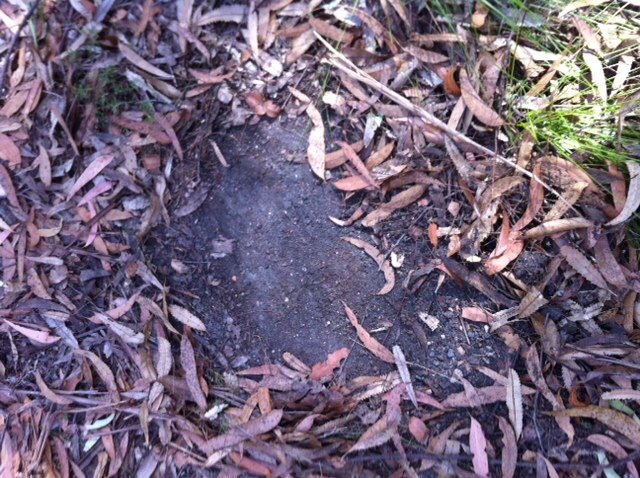
People are creatures of habit and there appears to be consistent themes in relation to the makeup of a mound. On many of the piles, the higher gravels/ topsoil appears on the uphill side of the mullock heap. When you think about it, the reason is obvious. When digging a shaft, the last thing a miner would want is rainwater running down the slope and into the hole. Therefore the first material taken out would be used to construct a bund to divert water before it becomes a problem. This results in much of the deeper gravel being deposited on the downhill side. Often the first of the gold bearing clay/ gravel is deposited in one small area on the mound. This material was ingnored by the early miners as they were after the rich pay layer at the bottom of the old river bed. Evidence of this material being removed at a later date (possibly during the depression years) exists on many mounds. The material has been benched out and removed for processing.
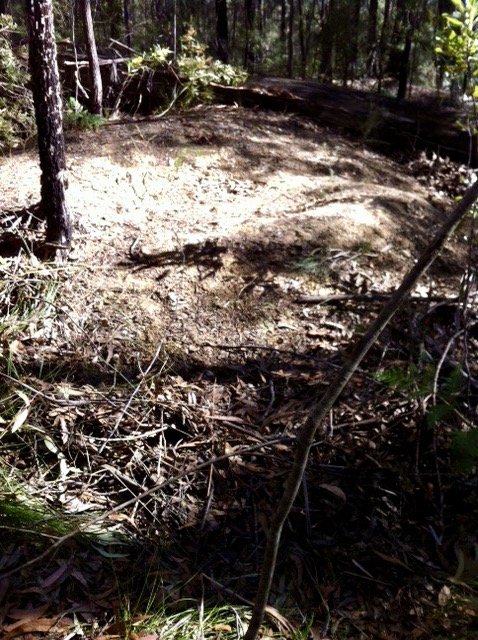
Detecting around this area sometimes produces a small surprise.
Not all mullock heaps follow this theory and I find that the safe thing to do is detect everywhere.
The final photo is the one that softens the expectations.
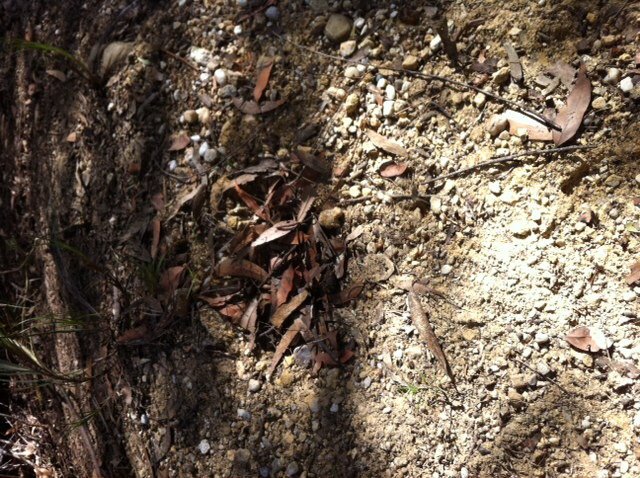
Evidence that someone else has been there with a detector. The hope is maybe they were lazy or the hole was dug a long time ago with a lesser technology. What it means is there is good chance that the big bits may have been grabbed. Regardless, the next step is so important. Go low and go slow. Expect the odd small bit and hope that the others who were there before you missed the wow piece.
Cheers for now
Les
Just thought I would share with you some observations about my local detecting area in southern NSW. I spend three of four mornings every week looking around the old alluvial workings in search for any sign of yellow left by the old timers. The area has been hit quite hard over the years and from what I have been told, it is becoming more difficult every day to find that bit of gold. I must admit that it does teach you patience and perseverance.
It is quite a difficult area to work. Most of the mullock heaps are either overgrown or covered in a deep layer of dead branches and rubbish.

Getting a coil close to the ground is hard work and I am sure that a lot of gold is still hidden under the build up of undergrowth and leaf litter. A bit of raking is often required to reveal the potential of the mound. After raking some interesting information about past activities and mullock heap makeup is evident.
In this area, the gold bearing gravel/ clay is generally a yellow/ orange colour.

Dark coloured soil or white sandy gravel is normally found close to ground level and has a lower chance of containing nuggets. Red clay and hot rocks appear to form another layer in the soil profile and do nothing but upset the detector. I spend some time on the lighter gravels and dark soil but avoid the red dirt like the plague. I mostly focus on the yellow/ orange material.

People are creatures of habit and there appears to be consistent themes in relation to the makeup of a mound. On many of the piles, the higher gravels/ topsoil appears on the uphill side of the mullock heap. When you think about it, the reason is obvious. When digging a shaft, the last thing a miner would want is rainwater running down the slope and into the hole. Therefore the first material taken out would be used to construct a bund to divert water before it becomes a problem. This results in much of the deeper gravel being deposited on the downhill side. Often the first of the gold bearing clay/ gravel is deposited in one small area on the mound. This material was ingnored by the early miners as they were after the rich pay layer at the bottom of the old river bed. Evidence of this material being removed at a later date (possibly during the depression years) exists on many mounds. The material has been benched out and removed for processing.

Detecting around this area sometimes produces a small surprise.
Not all mullock heaps follow this theory and I find that the safe thing to do is detect everywhere.
The final photo is the one that softens the expectations.

Evidence that someone else has been there with a detector. The hope is maybe they were lazy or the hole was dug a long time ago with a lesser technology. What it means is there is good chance that the big bits may have been grabbed. Regardless, the next step is so important. Go low and go slow. Expect the odd small bit and hope that the others who were there before you missed the wow piece.
Cheers for now
Les




